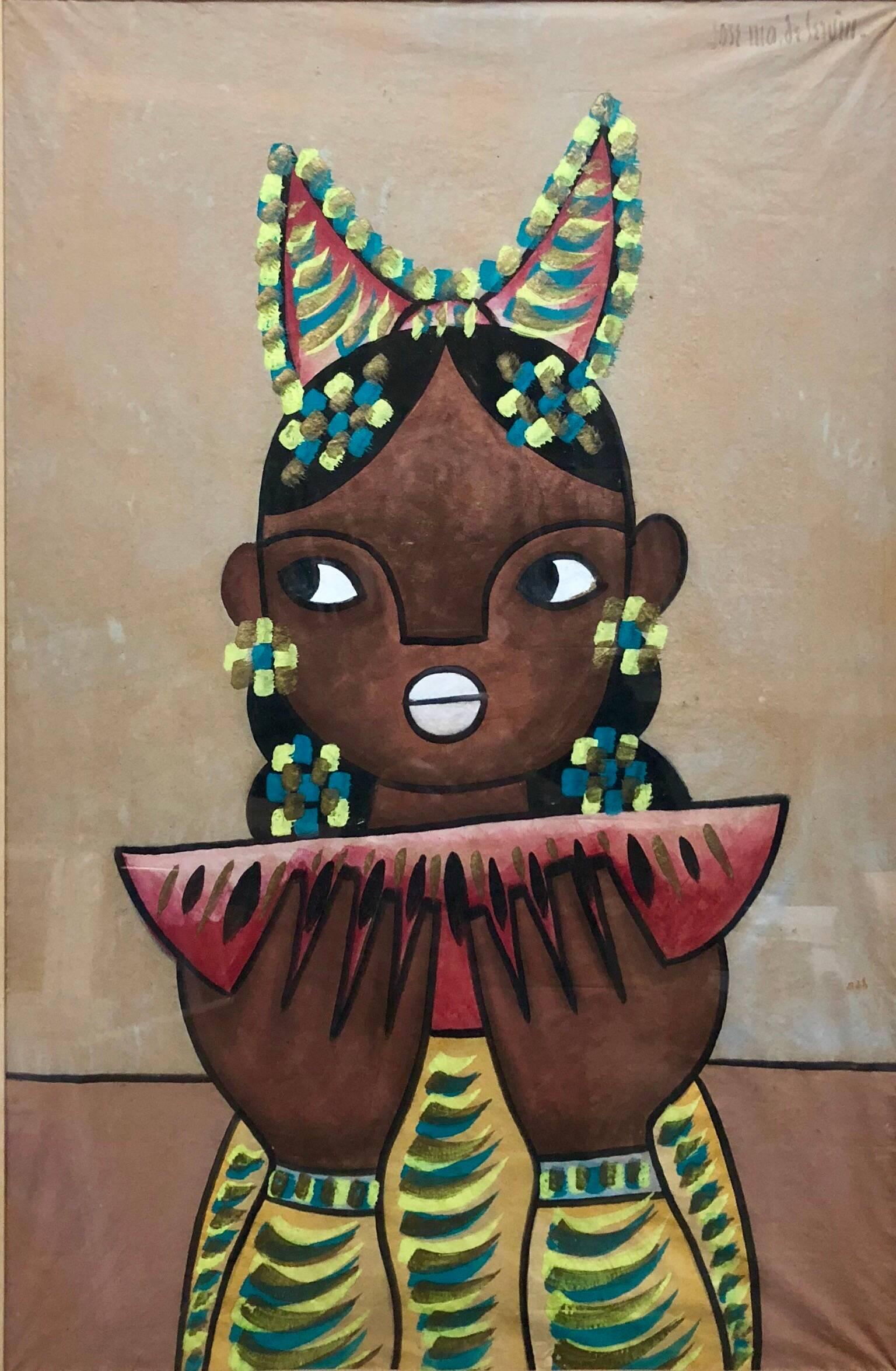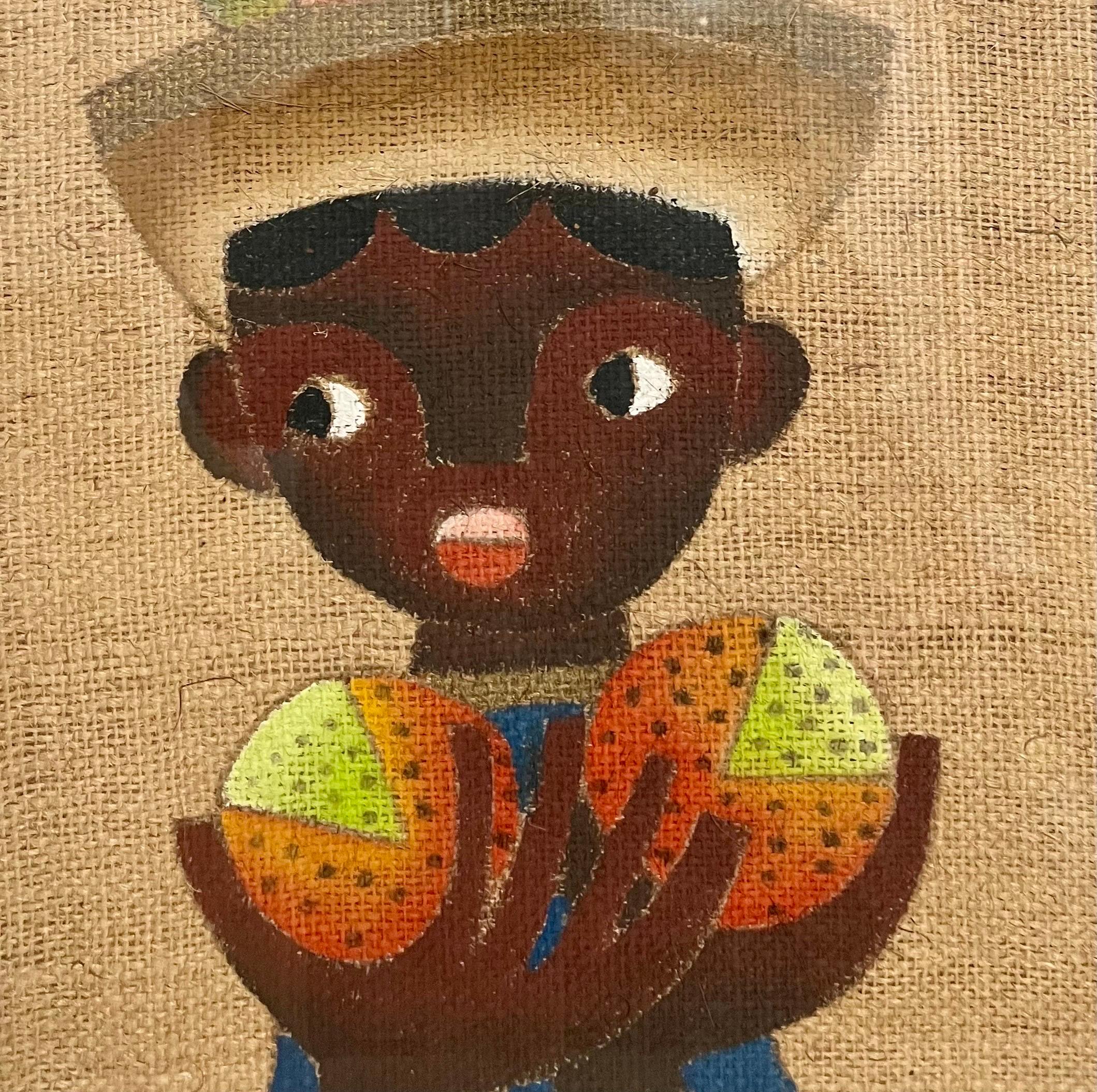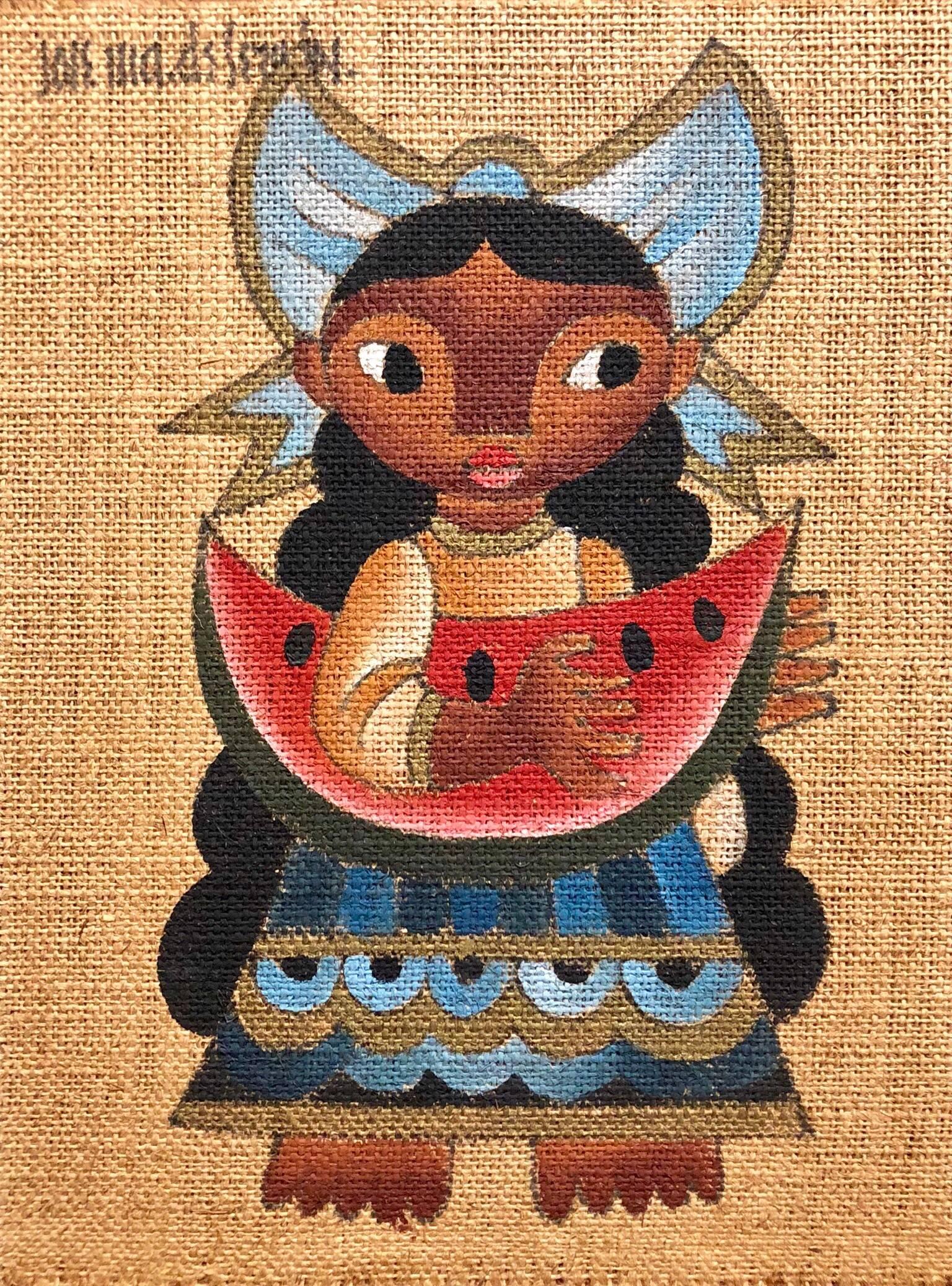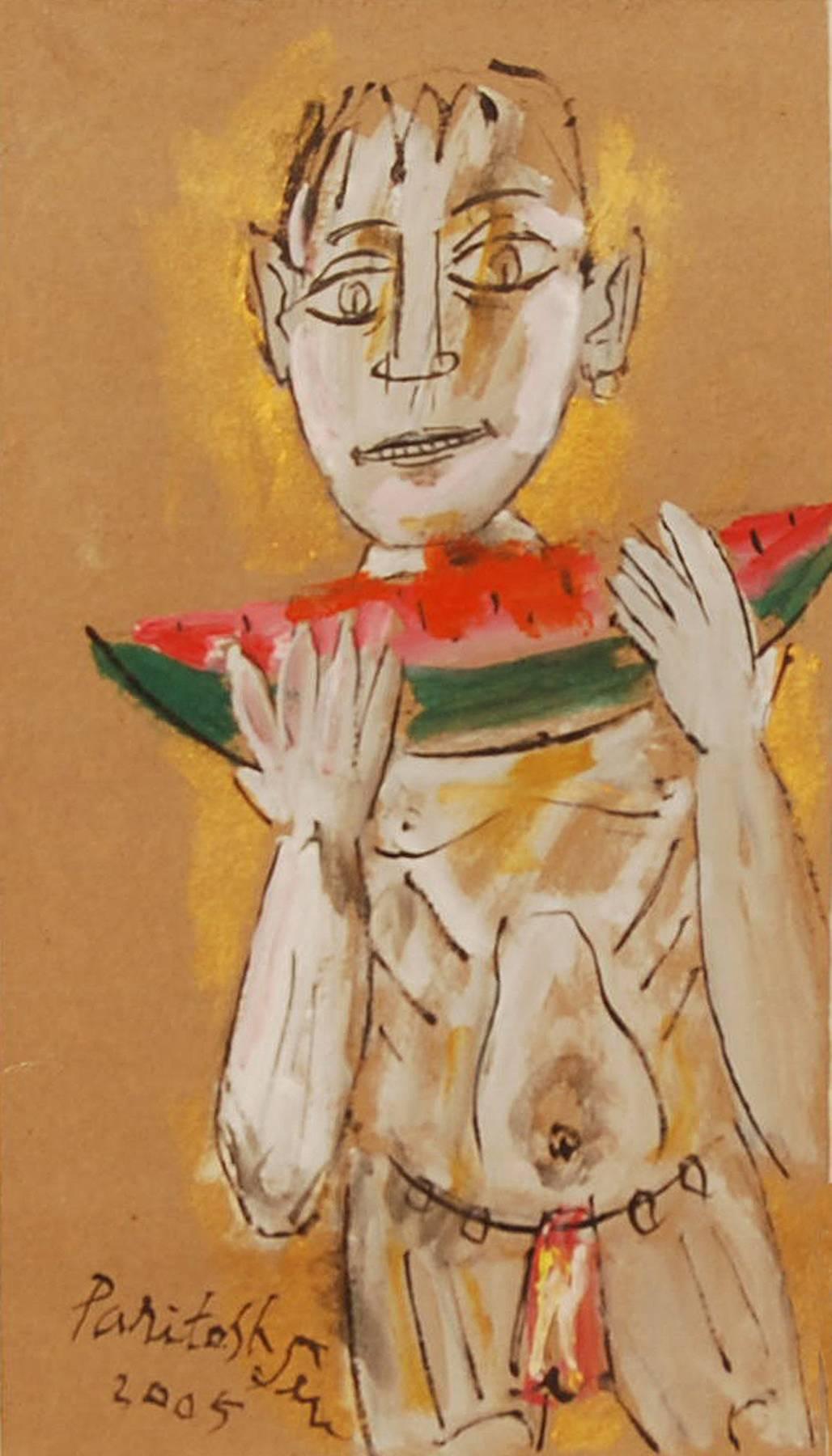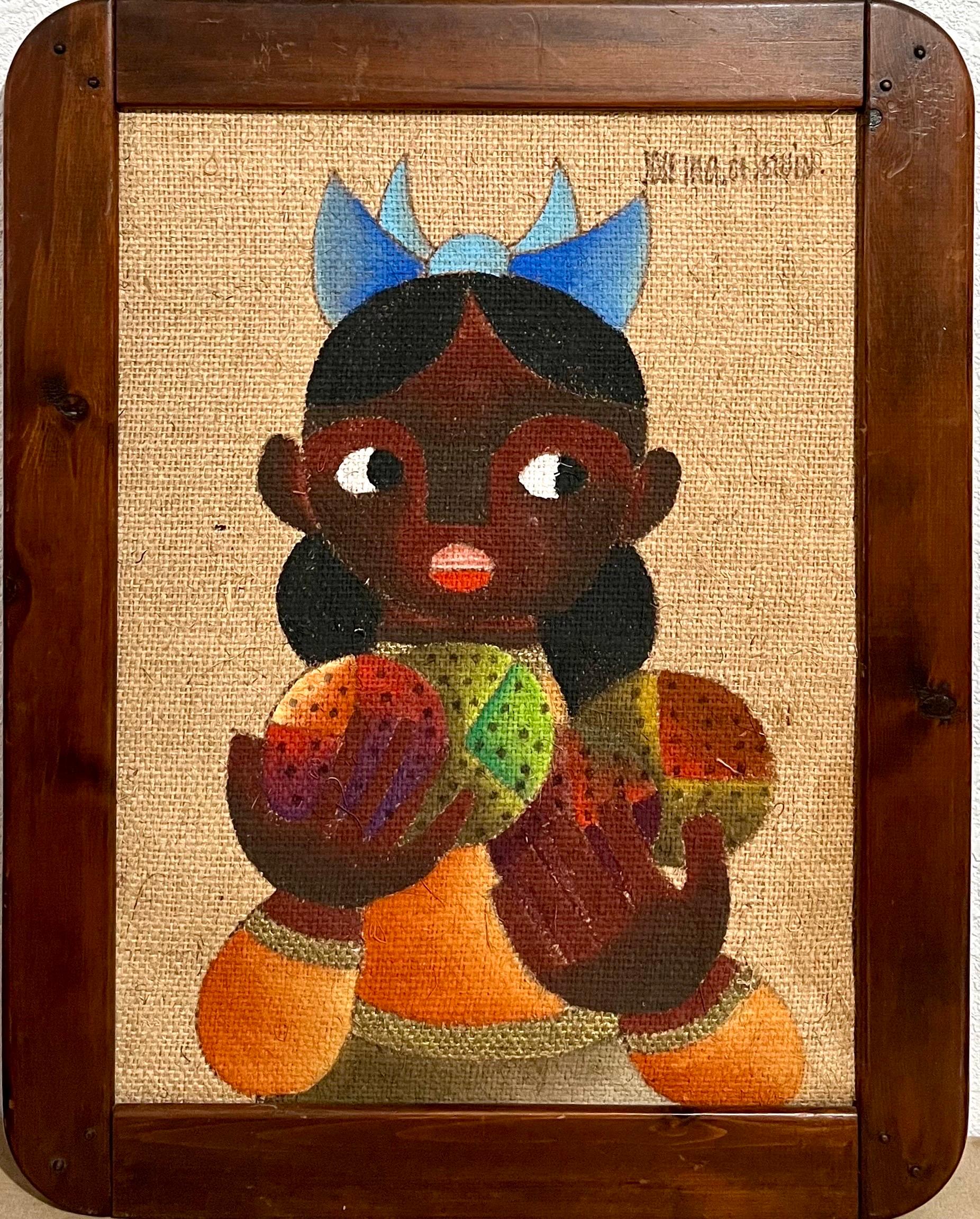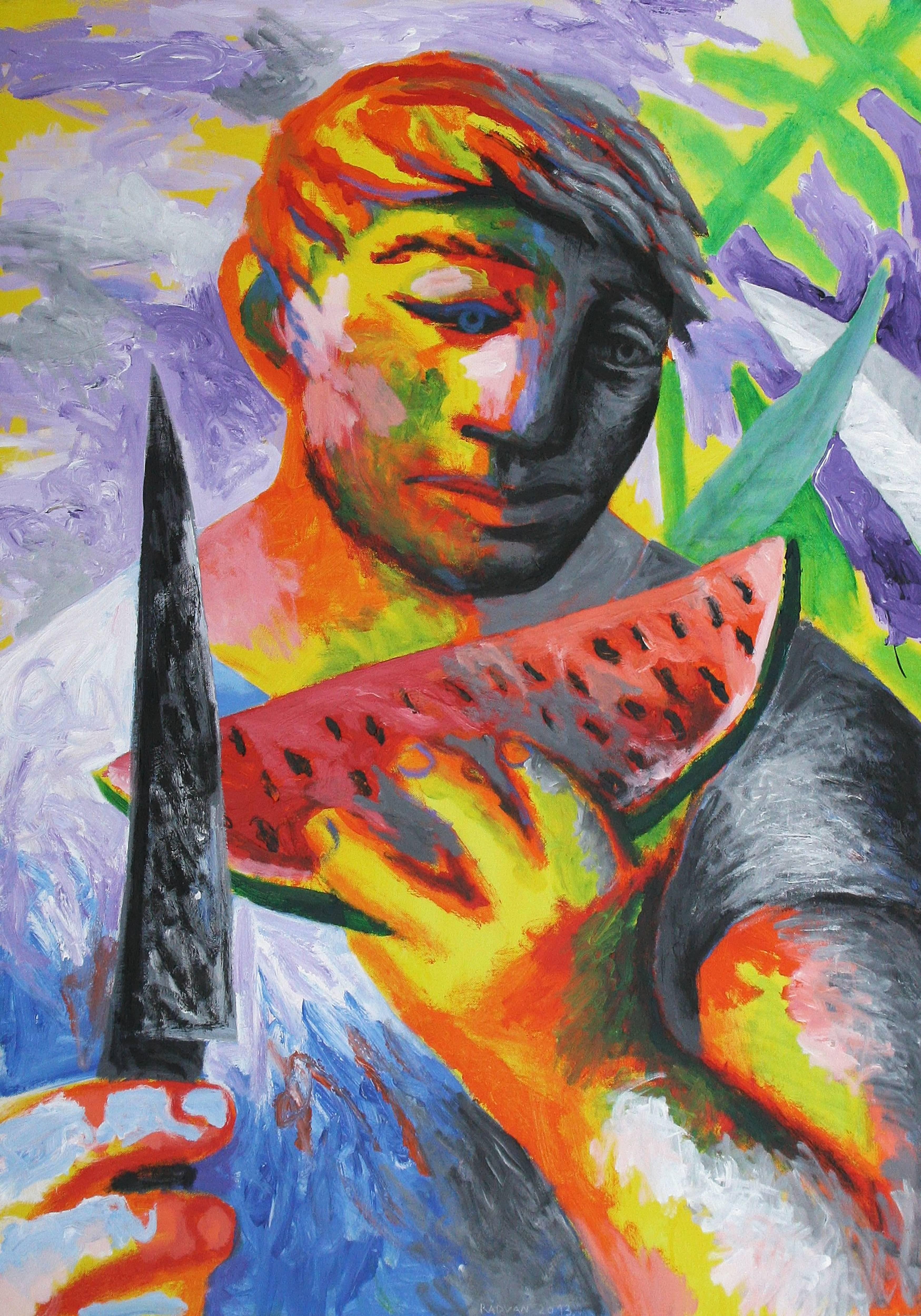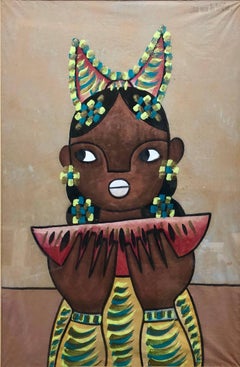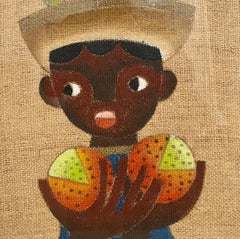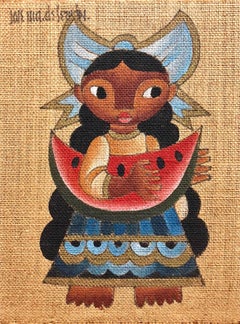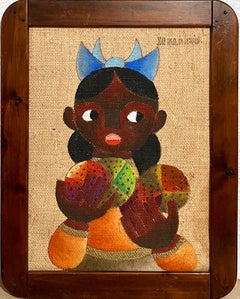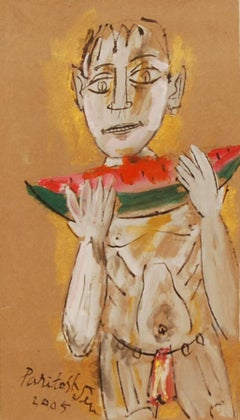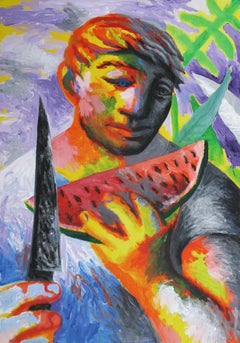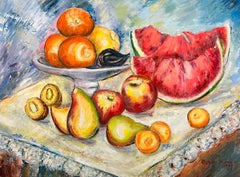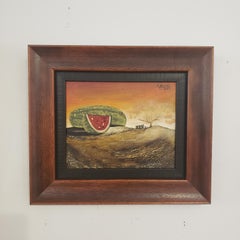Items Similar to Mexican Modernist Painting Boy with Watermelon
Want more images or videos?
Request additional images or videos from the seller
1 of 7
Jose Maria de ServinMexican Modernist Painting Boy with Watermelon
$1,600
£1,221.93
€1,399.65
CA$2,282.50
A$2,487.72
CHF 1,295.49
MX$30,016.15
NOK 16,284.85
SEK 15,287.68
DKK 10,453.64
About the Item
Genre: Latin American
Subject: Children
Medium: Mixed Media
Surface: Paper
Country: Mexico
Dimensions include Frame: 36X26
The sweetness that characterizes the work of Mexican painter Jose Maria de Servin (1917-83) is a melancholy and placid one. While he worked in the most modern of styles, he adapted it to an anecdotal folk-art approach distinctly his own.
When he was an infant, de Servin's family moved with him to Guadalajara. A city of history and culture, Guadalajara had a thriving artistic community with strong connections to Europe. His brothers Antonio and Miguel became artists as well, and in later years they worked collaboratively. As a teenager, de Servin studied at one of Mexico's Schools of Open-Air Painting, free art-teaching institutions sponsored by the government.
Later de Servin became a pupil of the painter Chucho Reyes, known for his improvisational watercolor variations on traditional Mexican themes. This interest in imagery particular to Mexico would be of great significance to de Servin. De Servin also studied under the more traditional painter Jose Vizcarra. In the early 1930s de Servin joined the Pintores Jovenes de Jalisco, or Young Painters of Jalisco.
An influence of critical importance to de Servin was Pablo Picasso. One of the originators of Cubism, the Spanish painter soon departed from its quasi-scientific and optical basis to create lively and humorous geometrical abstractions. It was this Cubism, personal and decorative, that de Servin adopted. His earliest Cubist works mimic Picasso, while during the second stage of his career, his works become smooth and polished, with an emphasis on gentle surface textures.
After these cautious years, however, a rough boldness enters along with dominating colors of earth and sand. Modernists like de Servin were interested in exploring what they considered primitive artmaking styles. The adoption of a native manner and native themes is in keeping with Modernist tenets, as is the use of nontraditional materials. De Servin's portraits of peasants, large-eyed and simply rendered, recall children's drawings. The rough burlap ground contrasts with the playful imagery and delicate range of color. The figures, all children or child-like adults, are all curves and simple shapes arranged harmoniously. De Servin's cubism is free from grotesquerie as it celebrates the simplicity of its subjects.
De Servin worked with the social-realist Jose Orozco on several large mural commissions in Guadalajara, including one at the Legislative Palace. While their styles were dissimilar, both made use of Mexican imagery to glorify the common people. A sought-after muralist in his own right, de Servin brought the rich colors and endearing characters of his panels to his larger-scale work.
For 15 years, de Servin taught summer art classes at the University of Arizona. His career was marked by many one-man shows, both in North America and Europe. In recent years, his striking style has attracted increased notice from critics and the public.
- Creator:Jose Maria de Servin (1917, Mexican)
- Dimensions:Height: 36 in (91.44 cm)Width: 26 in (66.04 cm)
- Medium:
- Movement & Style:
- Period:
- Condition:needs new mat and frame. minor wear please see photos.
- Gallery Location:Surfside, FL
- Reference Number:1stDibs: LU38212598052
About the Seller
4.9
Platinum Seller
Premium sellers with a 4.7+ rating and 24-hour response times
Established in 1995
1stDibs seller since 2014
1,823 sales on 1stDibs
Typical response time: 1 hour
- ShippingRetrieving quote...Shipping from: Surfside, FL
- Return Policy
Authenticity Guarantee
In the unlikely event there’s an issue with an item’s authenticity, contact us within 1 year for a full refund. DetailsMoney-Back Guarantee
If your item is not as described, is damaged in transit, or does not arrive, contact us within 7 days for a full refund. Details24-Hour Cancellation
You have a 24-hour grace period in which to reconsider your purchase, with no questions asked.Vetted Professional Sellers
Our world-class sellers must adhere to strict standards for service and quality, maintaining the integrity of our listings.Price-Match Guarantee
If you find that a seller listed the same item for a lower price elsewhere, we’ll match it.Trusted Global Delivery
Our best-in-class carrier network provides specialized shipping options worldwide, including custom delivery.More From This Seller
View AllMexican Modernist Painting Girl with Watermelon
By Jose Maria de Servin
Located in Surfside, FL
Genre: Latin American
Subject: Children
Medium: Mixed Media
Surface: Paper
Country: Mexico
Dimensions include Frame: 36X26
The sweetness that characterizes the work of Mexican pai...
Category
20th Century Folk Art Figurative Paintings
Materials
Paper, Gouache
Folk Art Mexican Boy Oil Painting on Burlap Charming Naive African American Art
By Jose Maria de Servin
Located in Surfside, FL
Framed 29 X 23
Image 18 X 24
The sweetness that characterizes the work of Mexican painter Jose Maria de Servin (1917-83) is a melancholy and placid one. While he worked in the most modern of styles, he adapted it to an anecdotal folk-art approach distinctly his own.
When he was an infant, de Servin's family moved with him to Guadalajara. A city of history and culture, Guadalajara had a thriving artistic community with strong connections to Europe. His brothers Antonio and Miguel became artists as well, and in later years they worked collaboratively. As a teenager, de Servin studied at one of Mexico's Schools of Open-Air Painting, free art-teaching institutions sponsored by the government.
Later de Servin became a pupil of the painter Chucho Reyes, known for his improvisational watercolor variations on traditional Mexican themes. This interest in imagery particular to Mexico would be of great significance to de Servin. De Servin also studied under the more traditional painter Jose Vizcarra. In the early 1930s de Servin joined the Pintores Jovenes de Jalisco, or Young Painters of Jalisco.
An influence of critical importance to de Servin was Pablo Picasso. One of the originators of Cubism, the Spanish painter soon departed from its quasi-scientific and optical basis to create lively and humorous geometrical abstractions. It was this Cubism, personal and decorative, that de Servin adopted. His earliest Cubist works mimic Picasso, while during the second stage of his career, his works become smooth and polished, with an emphasis on gentle surface textures.
After these cautious years, however, a rough boldness enters along with dominating colors of earth and sand. Modernists like de Servin were interested in exploring what they considered primitive artmaking styles. The adoption of a native manner and native themes is in keeping with Modernist tenets, as is the use of nontraditional materials. De Servin's portraits of peasants, large-eyed and simply rendered, recall children's drawings. The rough burlap ground contrasts with the playful imagery and delicate range of color. The figures, all children or child-like adults, are all curves and simple shapes arranged harmoniously. De Servin's cubism is free from grotesquerie as it celebrates the simplicity of its subjects.
De Servin worked with the social-realist Jose Orozco on several large mural commissions in Guadalajara, including one at the Legislative Palace. While their styles were dissimilar, both made use of Mexican imagery to glorify the common people. A sought-after muralist in his own right, de Servin brought the rich colors and endearing characters of his panels to his larger-scale work.
For 15 years, de Servin taught summer art classes at the University of Arizona. His career was marked by many one-man shows, both in North America and Europe. In recent years, his striking style has attracted increased notice from critics and the public.
His style is a unique conglomerate of tradition, history, legends, heroes, old customs and folklore. It is a self-standing style, recognizable, cheerful, whimsical and a happy creation. Naïve art is any form of visual art that is created by a person who lacks the formal education and training that a professional artist undergoes (in anatomy, art history, technique, perspective, ways of seeing). Unlike folk art, naïve art does not necessarily evince a distinct cultural context or tradition. Naïve art is recognized, and often imitated, for its childlike simplicity and frankness. Paintings of this kind typically have a flat rendering style with a rudimentary expression of perspective.
One particularly influential painter of "naïve art" was Henri Rousseau (1844–1910), a French Post-Impressionist who was discovered by Pablo Picasso. Naïve art is often seen as outsider art that is by someone without formal (or little) training or degree. While this was true before the twentieth century, there are now academies for naïve art. Naïve art is now a fully recognized art genre, represented in art galleries worldwide.
Museums devoted to naïve art now exist in Kecskemét, Hungary; Riga, Latvia; Jaen, Spain; Rio de Janeiro, Brasil; Vicq France and Paris. "Primitive art" is another term often applied to art by those without formal training, but is historically more often applied to work from certain cultures that have been judged socially or technologically "primitive" by Western academia, such as Native American, sub saharan African or Pacific Island art (see Tribal art). This is distinguished from the self-conscious, "primitive" inspired movement primitivism. Another term related to (but not completely synonymous with) naïve art is folk art. There also exist the terms "naïvism" and "primitivism" which are usually applied to professional painters working in the style of naïve art (like Paul Gauguin, Mikhail Larionov, Paul Klee).
At all events, naive art can be regarded as having occupied an "official" position in the annals of twentieth-century art since - at the very latest - the publication of the Der Blaue Reiter, an almanac in 1912. Wassily Kandinsky and Franz Marc, who brought out the almanac, presented 6 reproductions of paintings by le Douanier' Rousseau (Henri Rousseau), comparing them with other pictorial examples. However, most experts agree that the year that naive art was "discovered" was 1885, when the painter Paul Signac became aware of the talents of Henri Rousseau and set about organizing exhibitions of his work in a number of prestigious galleries. The Earth Group (Grupa Zemlja) were Croatian artists, architects and intellectuals active in Zagreb from 1929 to 1935. The group included the painters Krsto Hegedušić, Edo Kovačević, Omer Mujadžić, Kamilo Ružička, Ivan Tabaković, and Oton Postružnik, the sculptors Antun Augustinčić, Frano Kršinić, and the architect Drago Ibler. A term applied to Yugoslav (Croatian) naive painters working in or around the village of Hlebine, near the Hungarian border, from about 1930. Some of the best known naive artists are Dragan Gaži, Ivan Generalić, Josip Generalić, Krsto Hegedušić, Mijo Kovačić, Ivan Lacković-Croata, Franjo Mraz, Ivan Večenaj and Mirko Virius. Camille Bombois (1883–1970) Ferdinand Cheval, known as 'le facteur Cheval' (1836–1924) Henry Darger (1892–1973) L. S. Lowry (1887–1976) Grandma Moses, Anna Mary Robertson (1860–1961) Nikifor (1895–1968) Poland, Horace Pippin (1888–1946) Jon Serl (1894-1993) United States Alfred Wallis (1855–1942) Scottie Wilson (1890–1972) Gesner Abelard...
Category
Mid-20th Century Folk Art Figurative Paintings
Materials
Burlap, Oil
Folk Art Mexican Girl with Watermelon Oil Painting on Burlap
By Jose Maria de Servin
Located in Surfside, FL
The sweetness that characterizes the work of Mexican painter Jose Maria de Servin (1917-83) is a melancholy and placid one. While he worked in the most modern of styles, he adapted i...
Category
Mid-20th Century Folk Art Figurative Paintings
Materials
Burlap, Oil
Folk Art Mexican Girl Oil Painting on Burlap Charming Naive African American Art
By Jose Maria de Servin
Located in Surfside, FL
Framed 29 X 23
Image 18 X 24
The sweetness that characterizes the work of Mexican painter Jose Maria de Servin (1917-83) is a melancholy and placid one. While he worked in the most modern of styles, he adapted it to an anecdotal folk-art approach distinctly his own.
When he was an infant, de Servin's family moved with him to Guadalajara. A city of history and culture, Guadalajara had a thriving artistic community with strong connections to Europe. His brothers Antonio and Miguel became artists as well, and in later years they worked collaboratively. As a teenager, de Servin studied at one of Mexico's Schools of Open-Air Painting, free art-teaching institutions sponsored by the government.
Later de Servin became a pupil of the painter Chucho Reyes, known for his improvisational watercolor variations on traditional Mexican themes. This interest in imagery particular to Mexico would be of great significance to de Servin. De Servin also studied under the more traditional painter Jose Vizcarra. In the early 1930s de Servin joined the Pintores Jovenes de Jalisco, or Young Painters of Jalisco.
An influence of critical importance to de Servin was Pablo Picasso. One of the originators of Cubism, the Spanish painter soon departed from its quasi-scientific and optical basis to create lively and humorous geometrical abstractions. It was this Cubism, personal and decorative, that de Servin adopted. His earliest Cubist works mimic Picasso, while during the second stage of his career, his works become smooth and polished, with an emphasis on gentle surface textures.
After these cautious years, however, a rough boldness enters along with dominating colors of earth and sand. Modernists like de Servin were interested in exploring what they considered primitive artmaking styles. The adoption of a native manner and native themes is in keeping with Modernist tenets, as is the use of nontraditional materials. De Servin's portraits of peasants, large-eyed and simply rendered, recall children's drawings. The rough burlap ground contrasts with the playful imagery and delicate range of color. The figures, all children or child-like adults, are all curves and simple shapes arranged harmoniously. De Servin's cubism is free from grotesquerie as it celebrates the simplicity of its subjects.
De Servin worked with the social-realist Jose Orozco on several large mural commissions in Guadalajara, including one at the Legislative Palace. While their styles were dissimilar, both made use of Mexican imagery to glorify the common people. A sought-after muralist in his own right, de Servin brought the rich colors and endearing characters of his panels to his larger-scale work.
For 15 years, de Servin taught summer art classes at the University of Arizona. His career was marked by many one-man shows, both in North America and Europe. In recent years, his striking style has attracted increased notice from critics and the public.
His style is a unique conglomerate of tradition, history, legends, heroes, old customs and folklore. It is a self-standing style, recognizable, cheerful, whimsical and a happy creation. Naïve art is any form of visual art that is created by a person who lacks the formal education and training that a professional artist undergoes (in anatomy, art history, technique, perspective, ways of seeing). Unlike folk art, naïve art does not necessarily evince a distinct cultural context or tradition. Naïve art is recognized, and often imitated, for its childlike simplicity and frankness. Paintings of this kind typically have a flat rendering style with a rudimentary expression of perspective.
One particularly influential painter of "naïve art" was Henri Rousseau (1844–1910), a French Post-Impressionist who was discovered by Pablo Picasso. Naïve art is often seen as outsider art that is by someone without formal (or little) training or degree. While this was true before the twentieth century, there are now academies for naïve art. Naïve art is now a fully recognized art genre, represented in art galleries worldwide.
Museums devoted to naïve art now exist in Kecskemét, Hungary; Riga, Latvia; Jaen, Spain; Rio de Janeiro, Brasil; Vicq France and Paris. "Primitive art" is another term often applied to art by those without formal training, but is historically more often applied to work from certain cultures that have been judged socially or technologically "primitive" by Western academia, such as Native American, sub saharan African or Pacific Island art (see Tribal art). This is distinguished from the self-conscious, "primitive" inspired movement primitivism. Another term related to (but not completely synonymous with) naïve art is folk art. There also exist the terms "naïvism" and "primitivism" which are usually applied to professional painters working in the style of naïve art (like Paul Gauguin, Mikhail Larionov, Paul Klee).
At all events, naive art can be regarded as having occupied an "official" position in the annals of twentieth-century art since - at the very latest - the publication of the Der Blaue Reiter, an almanac in 1912. Wassily Kandinsky and Franz Marc, who brought out the almanac, presented 6 reproductions of paintings by le Douanier' Rousseau (Henri Rousseau), comparing them with other pictorial examples. However, most experts agree that the year that naive art was "discovered" was 1885, when the painter Paul Signac became aware of the talents of Henri Rousseau and set about organizing exhibitions of his work in a number of prestigious galleries. The Earth Group (Grupa Zemlja) were Croatian artists, architects and intellectuals active in Zagreb from 1929 to 1935. The group included the painters Krsto Hegedušić, Edo Kovačević, Omer Mujadžić, Kamilo Ružička, Ivan Tabaković, and Oton Postružnik, the sculptors Antun Augustinčić, Frano Kršinić, and the architect Drago Ibler. A term applied to Yugoslav (Croatian) naive painters working in or around the village of Hlebine, near the Hungarian border, from about 1930. Some of the best known naive artists are Dragan Gaži, Ivan Generalić, Josip Generalić, Krsto Hegedušić, Mijo Kovačić, Ivan Lacković-Croata, Franjo Mraz, Ivan Večenaj and Mirko Virius. Camille Bombois (1883–1970) Ferdinand Cheval, known as 'le facteur Cheval' (1836–1924) Henry Darger (1892–1973) L. S. Lowry (1887–1976) Grandma Moses, Anna Mary Robertson (1860–1961) Nikifor (1895–1968) Poland, Horace Pippin (1888–1946) Jon Serl (1894-1993) United States Alfred Wallis (1855–1942) Scottie Wilson (1890–1972) Gesner Abelard...
Category
Mid-20th Century Folk Art Figurative Paintings
Materials
Burlap, Oil
Folk Art Mexican Girl, Circus Clown Juggler
By Jose Maria de Servin
Located in Surfside, FL
The sweetness that characterizes the work of Mexican painter Jose Maria de Servin (1917-83) is a melancholy and placid one. While he worked in the most modern of styles, he adapted i...
Category
Mid-20th Century Folk Art Figurative Paintings
Materials
Burlap, Oil
Large Latin American Modernist Oil Paintng Women with Fruit
By Alexis Duque
Located in Surfside, FL
depicting two women, deshabille, partially nude with tropical fruit. surrealist.
Alexis Duque
Imaginatively charting the psychological experience of space, Alexis Duque produces pai...
Category
21st Century and Contemporary Contemporary Figurative Paintings
Materials
Canvas, Acrylic
You May Also Like
Boy eating Fruit, Figurative in Acrylic on Board by Indian Artist Paritosh Sen
By Paritosh Sen
Located in Kolkata, West Bengal
Boy eating Corn by Great Modern Indian Artist Paritosh Sen
20 x 12 inches (unframed size) - Acrylic on board
Inclusive of shipment in a roll form.
Boy eating Fruit, figurative in a...
Category
Early 2000s Modern Figurative Paintings
Materials
Acrylic, Board
Watermelon - Figurative Painting, 21st Century, Colorful, Human, Fruit, Orange
By Alexandru Rădvan
Located in Baden-Baden, DE
Watermelon, 2013
Acrylic on canvas (Signed on reverse)
41 3/10 H × 28 1/2 W in
105 H × 72.5 W cm
The artwork "Watermelon" was part of the solo show “Epic”. This exhibition, as the a...
Category
2010s Neo-Expressionist Figurative Paintings
Materials
Canvas, Acrylic
Watermelons & Fruit Large Modernist Still Life Painting Spanish Artist
Located in Cirencester, Gloucestershire
Fruit
by Maria Tort Xirau (Catalan, 1924-2018)
signed lower corner
dated 1993
oil painting on canvas, framed
framed: 24 x 33 inches
canvas: 20 x 29 inches
Very good condition.
Provenance: private collection
Maria Tort Xirau ( Figueres , 26 May 1924 – 6 June 2018) was a painter and photographic and cinematographic editor from Emporda. She developed a long professional career in leading photographic studios, in films for The Walt Disney Company and also in advertising claims for companies such as Educa Borràs . The second half of her life was dedicated to painting, exercising a luminous, varied and nostalgic chromatic style in the techniques of oil and watercolor and with exhibitions of her work in Barcelona and Figueres. The Biographical Dictionary of Art Empordà defined Tort Xirau's work as "a painting that is characterized by the strength of the strokes, the vividness and brightness of the chromatic range and exudes mastery of the photographic technique. A mixture of nostalgia and tenderness is evident.".
Tort Xirau's paintings were exhibited in the two towns where she spent her life: in 1992 she exhibited his work at the Caixa de Figueres Exhibition Hall. Two years later, she did it at Sala Conex in Barcelona and in 2007 and 2013 the Consortium of Sant Ferran Castle and the Figueres Town Council organized tribute exhibitions. In 2013, she ceded to the council of the city of Figueres her work Mercat de la plaça de l'Ajuntament , watercolored on paper around 1991, which is exhibited in the rest room of the building.
On June 6, 2018, she died in Figueres at the age of 94, receiving the apostolic blessing . Two years after her death, part of her paintings were included in the exhibition Paint, create, live. Women artists in the Alt...
Category
Late 20th Century Impressionist Figurative Paintings
Materials
Canvas, Oil
Sandia (Watermelon) Surreal Emerging Artist National Academy of Art of Uruguay
Located in Houston, TX
Carlos Duarte is an emerging young artist at the National School of Fine Arts Institute in Montevideo, Uruguay. The gallery has taken on several pieces from several students at the...
Category
2010s Realist Landscape Paintings
Materials
Oil, Panel
"WATERMELON TIME" Premier Black Folk Artist Johnny Banks Died 1988
By Johnny Banks
Located in San Antonio, TX
Johnny Banks
(1912-1988)
San Antonio Artist
Image Size: 11.5 x 9.5
Frame Size: 21.75 x 15.75
Medium: Multimedia on Poster Board
1987
"Watermelon Time"
Johnny Banks (1912-1988)
In my ...
Category
1980s Folk Art Mixed Media
Materials
Mixed Media
Watermelon and Knife Still Life Painting on Wood
Located in Queens, NY
Vintage (20th Century) still life acrylic painting of sliced and eaten watermelon with a knife on a surface draped in beige cloth, painted on rectangular plywood.
Imperfections in w...
Category
20th Century American Mid-Century Modern Paintings
Materials
Acrylic, Wood
More Ways To Browse
Paper Art Mexico
Watercolor Mexico
Mexican Folk Art Painting
Watermelon Paintings
Watermelon Folk Art
Mexican Boy Painting
Large Woodblock Prints
Marine Corps
Medusa Art
Oil Painting 1800
Skaters Painting
Ivan Albright
Jean Gabriel Domergue
Oil Painting Girl With Dog
St John The Baptist
1960s Figurative Oil Paintings
Der Blaue Reiter
Frans Hals
